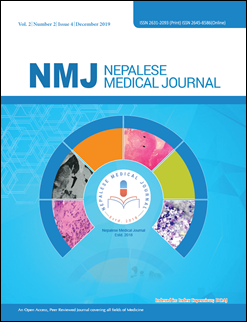Diffuse Alveolar Haemorrhage: A Single Centre Experience
DOI:
https://doi.org/10.3126/nmj.v2i2.25828Keywords:
Alveolar; ANCA; Bronchoalveolar lavage; Collagen vascular disease; VasculitisAbstract
Introduction: Diffuse alveolar hemorrhage results from an accumulation of red blood cells into the alveolar space. Symptoms of alveolar hemorrhage are dyspnea, hemoptysis, anemia, diffuse pulmonary infiltrates and hypoxemic respiratory failure. Diagnosis is established by bronchoalveolar lavage and treatment includes a combination of high dose systemic corticosteroids, immunosuppressant and plasma exchange. The aim of this study is to evaluate the clinical radiological profile and laboratory findings and utility of bronchoalveolar lavage in the diagnosis of diffuse alveolar hemorrhage.
Materials and Methods: In a retrospective review between February 2017 and December 2017, medical records of patients with a diagnosis of diffuse alveolar hemorrhage presenting at the National Academy of Medical Sciences, Kathmandu, Nepal, were analyzed. Clinical, radiology and laboratory results along with bronchoalveolar lavage results were extracted. Treatment received and clinical responses were evaluated.
Results: A total of five patients were diagnosed to have diffuse alveolar hemorrhage based on bronchoalveolar lavage analysis. Three had hemorrhage secondary to Antineutrophil Cytoplasmic Antibody associated vasculitis, one had Systemic Lupus Erythematosus and the other Idiopathic Pulmonary Hemosiderosis. Renal involvement was present in three patients. All patients received systemic corticosteroids, three received Cyclophosphamide and one Rituximab for remission induction. Plasma exchange was done in two patients with severe hypoxemia. Of the five patients, four improved whereas one died.
Conclusions: Diffuse alveolar hemorrhage presents with non-specific symptoms. Bronchoalveolar lavage is extremely useful to establish the diagnosis and exclude infections. Early initiation of immunosuppressant prevents respiratory failure and death.
Downloads
Downloads
Published
How to Cite
Issue
Section
License
This license enables reusers to distribute, remix, adapt, and build upon the material in any medium or format, so long as attribution is given to the creator. The license allows for commercial use.
Copyright on any article published by Nepalese Medical Journal is retained by the author(s).
Authors grant Nepalese Medical Journal a license to publish the article and identify itself as the original publisher.
Authors also grant any third party the right to use the article freely as long as its integrity is maintained and its original authors, citation details and publisher are identified.




